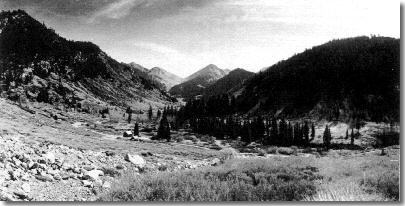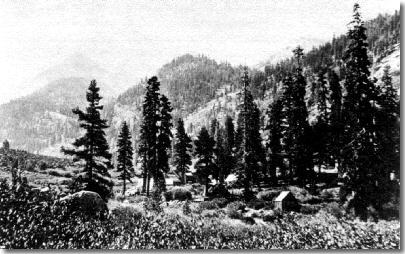A Town Called "Beulah"
A few miles to the south of Eshom Valley is a secluded valley of the Sierras. This valley was first discovered by white man in 1862 when Harry Parole came over a mountain pass to first see a valley that before had been secluded by the surrounding mountains. This valley was above the mining belt of the foothills, the lower canyons too rugged for trappers and too remote for livestock grazing.
 |
Harry established the first camp here at Harry's Bend |
As Harry entered the valley he was wild game everywhere. Deer were lying in groups under the fir and aspen trees. More timid than the deer, mountain sheep could be seen on the mountain sides. Bear, marmots grouse and other animals were abundant.
Eventually, mines went into operation. The first was the "Yellow Jacket", a small claim by Harry. Others including some larger mines, were the White Chief and the Empire mines. By 1873, more than sixty mining claims had been filed in Visalia. A water-run sawmill started up as did a smelter and an assay office. A road was constructed to get to the many cabins that were being built. A town began to grow and became known as "Beulah", the biblical land of beauty; land of expectation, land of promise and a land of hope.
The winter of 1879-80 brought disastrous snow storms. An avalanche roared down the slopes and engulfed many of the buildings. Twenty men were sleeping at the Empire Mine bunkhouse and were swept down the mountainside. Four of the men were badly injured. Not only was the bunkhouse gone, but so was the tramway that hauled the ore down to the mill. Financing was unavailable and this was the end of the Empire Mine. After eighteen feet of snow, men from the White Chief Mine tried to snow shoe out and were caught in another snow avalanche. Their bodies were found the following April.
 |
Beulah lost most of her permanent residents as many left with only summer visitors remaining. By 1905 the valley had become a family resort. But soon, a second disaster was to take place. On April 18, 1906 the San Francisco earthquake rocked all of California. This earthquake triggered massive snowslides from every wall of the valley. Avalanches roared down the mountainside and into the valley. Not one cabin escaped at least some level of damage. Many were completely destroyed.
In 1915, the road was improved to the valley. A new hotel was opened with rates of$2.50 per room, breakfast $1.00, lunch $1.25, dinner $1.50 and baths, 50 cents. Private cabins sprang up and families came in, sometimes just for the weekend. The automobile make the Californians more mobile and they would flock to the valley and became regular summer visitors. Another 100 cabins would be built. By 1950 the valley became a historic site to visit. The remnants of the mines and sawmills drew many visitors.
In 1947 a survey of the valley was made for consideration of a ski area. This alpine valley was an ideal location and was better than any other place in this hemisphere. A proposal of ten ski runs, an all weather highway and winter accommodations was considered. By 1962 a monorail was considered to move the 20,000 skier on a weekend. The biggest hurdle was the estimated cost of $5 million to construct the road.
Later, the proposal grew to a 14 ski lifts, three tiered parking, a chapel, ice skating rink, swimming pools, shops, theater, post office, store, restaurants, two hotels and more. It finally appeared that the Walt Disney Corporation would be the company awarded the contract. This was all for naught. The efforts of the Sierra Club and some of the local residents, stepped forward. A long court battled ensued. After several long delays, the proposed cost for the road alone grew ten fold. These battles continued until in 1979 a congressional bill transferred the area into the park service. There would be no developed ski area.
The mountain pass through which Harry hiked that day in 1862 was later named Farewell Gap, and the valley, Mineral King.